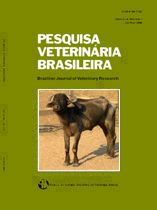 |
|
|
|
Year 2011 - Volume 31, Number 12
|

|
Breed and season influence on milk quality parameters and in mastitis occurrence, 31(12):1045-1052
|
ABSTRACT.- Nóbrega D.B. & Langoni H. 2011. Breed and season influence on milk quality parameters and in mastitis occurrence. Pesquisa Veterinária Brasileira 31(12):1045-1052. Departamento de Higiene Veterinária e Saúde Pública, Faculdade de Medicina Veterinária e Zootecnia, Universidade Estadual Paulista, Distrito de Rubião Júnior s/n, Botucatu, SP 18618-900, Brazil. E-mail: higivet@fmvz.unesp.br
The aims of the present study were to evaluate the performance of Jersey and Holstein cows under different rainfall conditions (dry and rainy seasons) by monitoring aspects related to subclinical mastitis (somatic cell count, microbiological isolation, type of isolated pathogen), milk quality (lactose, protein, fat, total solids) and production (mean milk production) of both breeds. The study was carried out in a dairy farm located in the state of São Paulo, Brazil. Eight visitations were done to the farm, four in a period of high rainfall and four in a period of low rainfall. Milk samples were collected from 79 Holstein cows and 37 Jersey cows for electronic somatic cell count and determination of the main milk components (protein, fat, total solids, lactose). Milk fat, protein, total solids and production were influenced by breed and the season, with similar tendencies for both breeds in both seasons. Somatic cell count (SCC) showed similar results for both breeds. Holstein cows with intramammary infections (IMI) presented a higher increase in SCC when compared to Jersey cows (P<0.001). In the dry season, 53 animals had IMI in at least one month during the study, which 32 were Holstein and 21 were Jersey cows. In the rainy season, 65 animals had intramammary infection, being 43 Holstein and 22 Jersey cows. The frequency of IMI cases was larger in the rainy season than in the dry season. Jersey cows had a lower chance of showing IMI signs and symptoms than Holstein cows in the rainy season (odds ratio=0.52). The larger number of IMI cases in the rainy season may have led to a lower milk lactose rate for both breeds, thus milk lactose rate can be considered an indicator of IMI status. There was prevalence of contagious pathogens overall in the study. The applied model showed that environmental pathogens were more frequently isolated from the breed Jersey, regardless of the study season. There seems to be differences in the immune response of Jersey and Holstein breeds |
| |
|
|
| |
|
 |